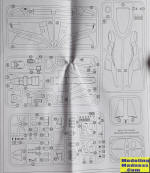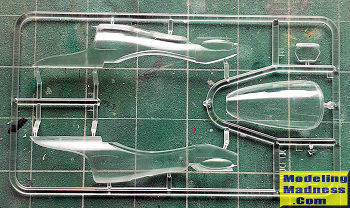
| KIT #: | 72372 |
| PRICE: | $35.00 |
| DECALS: | Two options |
| REVIEWER: | John Summerford |
| NOTES: | Short run kit |

| HISTORY |
Courtesy of Wikipedia
The Cobalt Co50 Valkyrie is a single-engine, four to five-seat homebuilt aircraft, arranged in a canard, pusher configuration. A light aircraft intended for private ownership, it was initially developed by Cobalt Aircraft of San Francisco, California, but the company ceased operations in July 2018 and the design is now being developed by the Centauri Aircraft Company.
The composite design incorporates retractable landing gear, a pusher engine configuration, a canard, twin vertical stabilizers and automatic airbrakes. A ballistic parachute is provided as an option. Kit production is planned to be carried out in the United States.
As of 2020, two airframes have been certified.
At a quick glance, the Valkyrie looks like an upsized Rutan VariEze with similar wing planform and canard. Wingspan of Valkyrie is 30 ft (9.1 m) versus the VariEze’s 22 ft 2.5 in (6.77 m). Seating capacity is five versus two respectively. I’m not sure, but I think the middle passenger will be squeezed by his seatmates.
| THE KIT |
 A
photo of Valkyrie parked on the tarmac and insert photos providing different
views adorns the box lid. A yellow triangle in the lower left corner proclaims
“Only 500pcs”. I thought that was referring to a jigsaw puzzle, but it has been
suggested to me that it means that Amodel produced 500 copies. The instructions
note that kit is based on "short-run technology and only for experienced
modelers"
A
photo of Valkyrie parked on the tarmac and insert photos providing different
views adorns the box lid. A yellow triangle in the lower left corner proclaims
“Only 500pcs”. I thought that was referring to a jigsaw puzzle, but it has been
suggested to me that it means that Amodel produced 500 copies. The instructions
note that kit is based on "short-run technology and only for experienced
modelers"
Indeed, the four gray sprues look
similar in style to those of a Dora Wings kit. Some flash is present and detail
is suitable for the scale. Interestingly, the fuselage halves are clear and the
canopy is a separate piece. It's hard to see, but there are two windows on each
side aft of the canopy for the rear seat occupants. A small fret of photo-etch,
vinyl masks,
and decals complete the kit. Total parts count is 96, including a six-piece
boarding ladder.
masks,
and decals complete the kit. Total parts count is 96, including a six-piece
boarding ladder.
Assembly starts with the cockpit and it, plus a rear bulkhead is trapped in the fuselage halves in step 4, The next six steps build the wings and mating them to the fuselage. Landing gear and prop sub-assemblies follow. In step 14, the instructions do not call attention to a choice that has to made. If one wishes to pose the canopy closed, the coming piece B1 should be glued in place as shown. Step 15 adds the underside bits, followed by step 16 that calls for adding the fins and closed canopy. The next four steps illustrate how to install the canopy open, again without highlighting this as an option.
 A closed
canopy would make painting much easier because masking an exposed cockpit is a
challenge. Two options for paint schemes are printed on a separate sheet. Option
one is a trendy gloss black plane with white lettering and option two is
aluminum paint with black lettering. Or, one could think of this as a blank
canvas and do a “Luft 2022” and let one’s imagination run wild.
A closed
canopy would make painting much easier because masking an exposed cockpit is a
challenge. Two options for paint schemes are printed on a separate sheet. Option
one is a trendy gloss black plane with white lettering and option two is
aluminum paint with black lettering. Or, one could think of this as a blank
canvas and do a “Luft 2022” and let one’s imagination run wild.
| CONCLUSIONS |
The parts layout looks sensible and the build sequence is conventional, so this looks like a good short run kit that will probably take patience to assemble and should result in an interesting model.
January 2022
Copyright ModelingMadness.com. All rights reserved. No reproduction in part
or in whole without express permission. If you would like your product reviewed fairly and
fairly quickly, please
contact
the editor or see other details in the
Note to
Contributors.